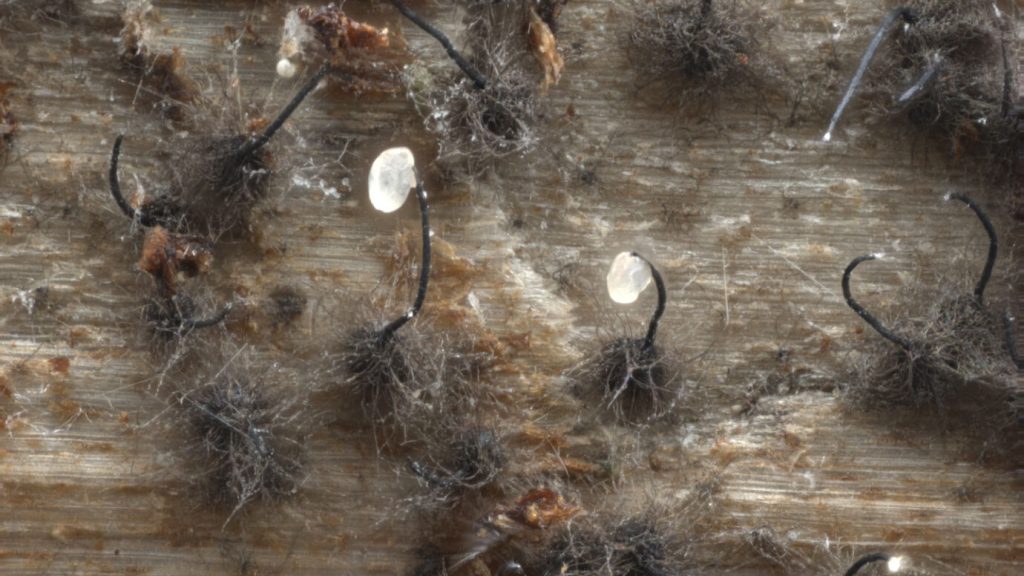Chemical signals from fungi tell bark beetles which trees to infest

Fungi may help some tree-killer beetles turn a tree’s natural defense system against itself.
The Eurasian spruce bark beetle (Ips typographus) has massacred millions of conifers in forests across Europe. Now, research suggests that fungi associated with these bark beetles are key players in the insect’s hostile takeovers. These fungi warp the chemical defenses of host trees to create an aroma that attracts beetles to burrow, researchers report February 21 in PLOS Biology.
This fungi-made perfume might explain why bark beetles tend to swarm the same tree. As climate change makes Europe’s forests more vulnerable to insect invasions, understanding this relationship could help scientists develop new countermeasures to ward off beetle attacks.
Bark beetles are a type of insect found around the world that feed and breed inside trees (SN: 12/17/10). In recent years, several bark beetle species have aggressively attacked forests from North America to Australia, leaving ominous strands of dead trees in their wake.
But trees aren’t defenseless. Conifers — which include pine and fir trees — are veritable chemical weapons factories. The evergreen smell of Christmas trees and alpine forests comes from airborne varieties of these chemicals. But while they may smell delightful, these chemicals’ main purpose is to trap and poison invaders.
Or at least, that’s what they’re meant to do.
“Conifers are full of resin and other stuff that should do horrible things to insects,” says Jonathan Gershenzon, a chemical ecologist at the Max Planck Institute for Chemical Ecology in Jena, Germany. “But bark beetles don’t seem to mind at all.”
This ability of bark beetles to overcome the powerful defense system of conifers has led some scientists to wonder if fungi might be helping. Fungi break down compounds in their environment for food and protection (SN: 11/30/21). And some type of fungi — including some species in the genus Grosmannia — are always found in association with Eurasian spruce bark beetles.
Gershenzon and his colleagues compared the chemicals released by spruce bark infested with Grosmannia and other fungi to the chemical profile of uninfected trees. The presence of the fungi fundamentally changed the chemical profile of spruce trees, the team found. More than half the airborne chemicals — made by fungi breaking down monoterpenes and other chemicals that are likely part of the tree defense system — were unique to infected trees after 12 days.
This is surprising because researchers had previously assumed that invading fungi hardly changed the chemical profile of trees, says Jonathan Cale, a fungal ecologist at the University of Northern British Columbia in Prince George, Canada, who was not involved with the research.
Later experiments revealed that bark beetles can detect many of these fungi-made chemicals. The team tested this by attaching tiny electrodes on bark beetles’ heads and detecting electrical activity when the chemicals wafted passed their antennae. What’s more, the smell of these chemicals combined with beetle pheromones led the insects to burrow at higher rates than the smell of pheromones alone.
The study suggests that these fungi-made chemicals can help beetles tell where to feed and breed, possibly by advertising that the fungi has taken down some of the tree’s defenses. The attractive nature of the chemicals could also explain the beetle’s swarming behavior, which drives the death of healthy adult trees.
But while the fungi aroma might doom trees, it could also lead to the beetles’ demise. Beetle traps in Europe currently use only beetle pheromones to attract their victims. Combining pheromones with fungi-derived chemicals might be the secret to entice more beetles into traps, making them more effective.
The results present “an exciting direction for developing new tools to manage destructive bark beetle outbreaks” for other beetle species as well, Cale says. In North America, mild winters and drought have put conifer forests at greater risk from mountain pine beetle (Dendroctonus pendersoae) attacks. Finding and using fungi-derived chemicals might be one way to fend off the worst of the bark beetle invasions in years to come.